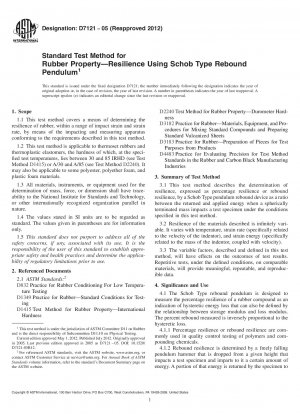ASTM D7121-05(2012)
Standard Test Method for Rubber Propertymdash;Resilience Using Schob Type Rebound Pendulum
- Standard No.
- ASTM D7121-05(2012)
- Release Date
- 2005
- Published By
- American Society for Testing and Materials (ASTM)
- Status
- Replace By
- ASTM D7121-05(2018)
- Latest
- ASTM D7121-05(2018)
- Scope
The Schob Type rebound pendulum is designed to measure the percentage resilience of a rubber compound as an indication of hysteretic energy loss that can also be defined by the relationship between storage modulus and loss modulus. The percent rebound measured is inversely proportional to the hysteretic loss.
Percentage resilience or rebound resilience are commonly used in quality control testing of polymers and compounding chemicals.
Rebound resilience is determined by a freely falling pendulum hammer that is dropped from a given height that impacts a test specimen and imparts to it a certain amount of energy. A portion of that energy is returned by the specimen to the pendulum and may be measured by the extent to which the pendulum rebounds, whereby the restoring force is determined by gravity.
Since the energy of the pendulum is proportional to the vertical component of the displacement of the pendulum, it may be expressed as 1 – cos (of the angle of displacement) and percentage rebound resilience. RB, commonly called percentage rebound, is determined from the equation:

The rebound resilience may be calculated as:

where: h = apex height of the rebound, and H = initial height. The rebound resilience may also be determined by the measurement of the angle of rebound α. From the rebound angle α, the rebound resilience in percent is obtained according to the following formula:

1.1 This test method covers a means of determining the resilience of rubber, within a range of impact strain and strain rate, by means of the impacting and measuring apparatus conforming to the requirements described in this test method.
1.2 This test method is applicable to thermoset rubbers and thermoplastic elastomers, the hardness of which, at the specified test temperatures, lies between 30 and 85 IRHD (see Test Method D1415) or A/30 and A/85 (see Test Method D2240). It may also be applicable to some polyester, polyether foam, and plastic foam materials.
1.3 All materials, instruments, or equipment used for the determination of mass, force, or dimension shall have traceability to the National Institute for Standards and Technology, or other internationally recognized organization parallel in nature.
1.4 The values stated in SI units are to be regarded as standard. The values given in parentheses are for information only.
1.5 This standard does not purport to address all of the safety concerns, if any, associated with its use. It is the responsibility of the user of this standard to establish appropriate safety and health practices and determine the applicability of regulatory limitations prior to use.
ASTM D7121-05(2012) Referenced Document
- ASTM D1349 Standard Practice for Rubber-Standard Temperatures for Testing
- ASTM D1415 Standard Test Method for Rubber Property—International Hardness
- ASTM D2240 Standard Test Method for Properties of Rubber &8212; Durometer Hardness*, 2024-04-19 Update
- ASTM D3182 Standard Practice for Rubber-Materials, Equipment, and Procedures for Mixing Standard Compounds and Preparing Standard Vulcanized Sheets
- ASTM D3183 Standard Practice for Rubber-Preparation of Pieces for Test Purposes from Products
- ASTM D4483 Standard Practice for Determining Precision for Test Method Standards in the Rubber and Carbon Black Industries
- ASTM D832 Standard Practice for Rubber Conditioning For Low-Temperature Testing
ASTM D7121-05(2012) history
- 2018 ASTM D7121-05(2018) Standard Test Method for Rubber Property—Resilience Using Schob Type Rebound Pendulum
- 2005 ASTM D7121-05(2012) Standard Test Method for Rubber Propertymdash;Resilience Using Schob Type Rebound Pendulum
- 2005 ASTM D7121-05 Standard Test Method for Rubber Property-Resilience Using Schob Type Rebound Pendulum
